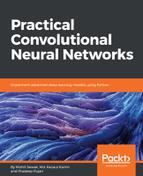Here we use MNIST (Modified National Institute of Standards and Technology), which consists of images of handwritten numbers and their labels. Since its release in 1999, this classic dataset is used for benchmarking classification algorithms.
The data files train.csv and test.csv consist of hand-drawn digits, from 0 through 9 in the form of gray-scale images. A digital image is a mathematical function of the form f(x,y)=pixel value. The images are two dimensional.
We can perform any mathematical function on the image. By computing the gradient on the image, we can measure how fast pixel values are changing and the direction in which they are changing. For image recognition, we convert the image into grayscale for simplicity and have one color channel. RGB representation of an image consists of three color channels, RED, BLUE, and GREEN. In the RGB color scheme, an image is a stack of three images RED, BLUE, and GREEN. In a grayscale color scheme, color is not important. Color images are computationally harder to analyze because they take more space in memory. Intensity, which is a measure of the lightness and darkness of an image, is very useful for recognizing objects. In some applications, for example, detecting lane lines in a self-driving car application, color is important because it has to distinguish yellow lanes and white lanes. A grayscale image does not provide enough information to distinguish between white and yellow lane lines.
Any grayscale image is interpreted by the computer as a matrix with one entry for each image pixel. Each image is 28 x 28 pixels in height and width, to give a sum of 784 pixels. Each pixel has a single pixel-value associated with it. This value indicates the lightness or darkness of that particular pixel. This pixel-value is an integer ranging from 0 to 255, where a value of zero means darkest and 255 is the whitest, and a gray pixel is between 0 and 255.
